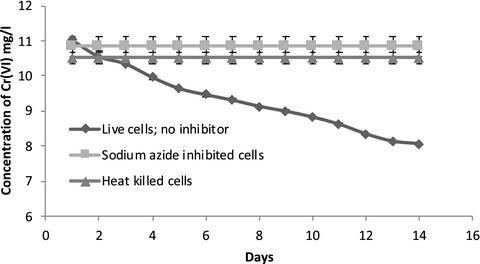当前位置:
X-MOL 学术
›
Lett. Appl. Microbiol.
›
论文详情
Our official English website, www.x-mol.net, welcomes your
feedback! (Note: you will need to create a separate account there.)
Isolation of a methane oxidising bacterium that bioremediates hexavalent chromium from a formerly industrialised suburban river
Letters in Applied Microbiology ( IF 2.0 ) Pub Date : 2020-06-18 , DOI: 10.1111/lam.13330 S Challa 1 , T J Smith 1
Letters in Applied Microbiology ( IF 2.0 ) Pub Date : 2020-06-18 , DOI: 10.1111/lam.13330 S Challa 1 , T J Smith 1
Affiliation

|
Sediment samples were taken from sediment adjacent to an urban river in Sheffield in Northern England that had suffered heavy metal pollution due to previous activity of the steel industry (between the 17th and 19th centuries). The most abundant heavy metals found in the samples were lead, chromium, nickel, arsenic and cobalt, with maximum concentrations of 412.80 mg kg-1 25.232 mg kg-1 , 25.196 mg kg-1 , 8.123 mg kg-1 and 7.66 mg kg-1 , respectively. Enrichment cultures were set up using methane as carbon and energy source, as a result of which a strain of methanotroph was isolated that was shown via 16S rRNA gene sequencing to be a strain Methylomonas koyamae and given the designation SHU1. M. koyamae SHU1 removed hexavalent chromium from an initial concentration of 10 ppm, which was inhibited by the metabolic inhibitor sodium azide or the methane monooxygenase inhibitor phenylacetylene. To the authors' knowledge this is the first description of a strain of the widely environmentally distributed genus Methylomonas that is capable of remediating hexavalent chromium.
中文翻译:

从以前工业化的郊区河流中生物修复六价铬的甲烷氧化细菌的分离
沉积物样本取自英格兰北部谢菲尔德城市河流附近的沉积物,该河流因先前的钢铁工业活动(17 至 19 世纪之间)而遭受重金属污染。样品中发现的最丰富的重金属是铅、铬、镍、砷和钴,最高浓度为 412.80 mg kg-1 25.232 mg kg-1 、25.196 mg kg-1 、8.123 mg kg-1 和 7.66 mg kg -1 ,分别。使用甲烷作为碳源和能源建立富集培养物,结果分离出一株甲烷氧化菌,通过 16S rRNA 基因测序显示该菌株是 Methylomonas koyamae 菌株,并命名为 SHU1。M. koyamae SHU1 从 10 ppm 的初始浓度中去除了六价铬,它被代谢抑制剂叠氮化钠或甲烷单加氧酶抑制剂苯乙炔抑制。据作者所知,这是对环境广泛分布的甲基单胞菌属菌株的首次描述,该菌株能够修复六价铬。
更新日期:2020-06-18
中文翻译:

从以前工业化的郊区河流中生物修复六价铬的甲烷氧化细菌的分离
沉积物样本取自英格兰北部谢菲尔德城市河流附近的沉积物,该河流因先前的钢铁工业活动(17 至 19 世纪之间)而遭受重金属污染。样品中发现的最丰富的重金属是铅、铬、镍、砷和钴,最高浓度为 412.80 mg kg-1 25.232 mg kg-1 、25.196 mg kg-1 、8.123 mg kg-1 和 7.66 mg kg -1 ,分别。使用甲烷作为碳源和能源建立富集培养物,结果分离出一株甲烷氧化菌,通过 16S rRNA 基因测序显示该菌株是 Methylomonas koyamae 菌株,并命名为 SHU1。M. koyamae SHU1 从 10 ppm 的初始浓度中去除了六价铬,它被代谢抑制剂叠氮化钠或甲烷单加氧酶抑制剂苯乙炔抑制。据作者所知,这是对环境广泛分布的甲基单胞菌属菌株的首次描述,该菌株能够修复六价铬。











































 京公网安备 11010802027423号
京公网安备 11010802027423号